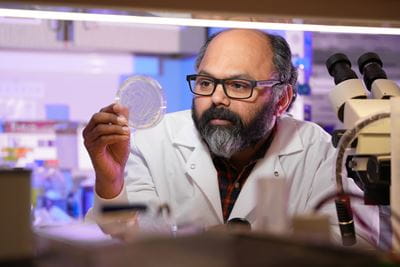
The laboratory of
Padmanabhan Pattabiraman, PhD, studies the pathophysiology and treatment paradigms for primary open-angle glaucoma (POAG). The lab focuses on the following three lines of research:
- Understanding the role of mechanobiology in ocular tissues and importantly in the regulation of aqueous humor outflow regulation. This project mainly deals with examining the molecular mechanisms involved in the regulation of extracellular matrix production, remodeling and degradation in the aqueous humor outflow pathway.
- Understanding the role of chaperone protein clusterin in aqueous humor outflow physiology. Clusterin is a secretory chaperone protein found in the aqueous humor and produced by trabecular meshwork, iris, ciliary body and other ocular tissues. Clusterin plays an important role in regulating cell-cell adhesion and cell-substratum/matrix interactions. The levels of clusterin mRNA has been shown to be lowered in POAG and the biochemical and functional interactome of genes implicated in ocular hypertension reveal a putative linkage of clusterin gene in the POAG pathogenesis. Yet very little is known about the role of clusterin in outflow biology. The lab studies the mechanistic role of clusterin in IOP regulation.
- Understanding the structure and function of trabecular outflow tissues differ between people of African and European Descent. Lacking is knowledge of differences in the ECM architecture and compaction in normal and POAG eyes in AD and ED. Researchers couple structure of the TM (molecular and cellular) with its function (outflow facility) in non-glaucomatous and glaucomatous donor eyes to identify differences in ocular physiology among AD and ED.
 The laboratory of Padmanabhan Pattabiraman, PhD, studies the pathophysiology and treatment paradigms for primary open-angle glaucoma (POAG). The lab focuses on the following three lines of research:
The laboratory of Padmanabhan Pattabiraman, PhD, studies the pathophysiology and treatment paradigms for primary open-angle glaucoma (POAG). The lab focuses on the following three lines of research:
